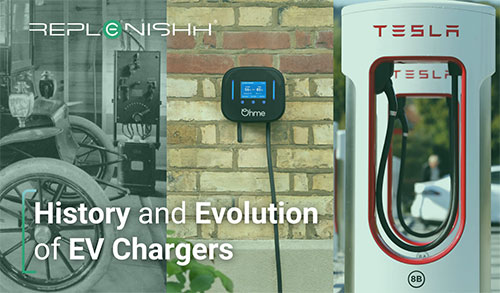
Electric vehicle chargers boast a history longer than one might anticipate. In the mid-19th century, the inception of electric vehicles marked their initial development, and by the 20th century, they experienced a notable surge in popularity. As electric vehicles evolve, so do the charging systems that underpin them. In this article, we offer you a glimpse into the historical progression of EV chargers, providing insight into their development over time and leading up to the cutting-edge solutions available at Replenishh today.
As electric vehicles gained traction and popularity throughout the late 20th century, the emergence of a dedicated charging infrastructure followed. Electric vehicle charging dates back to the late 19th to early 20th century, with minimal charging infrastructure in place. Electric vehicles were commonly charged with basic stations and plugged into standard electrical outlets. However, due to their status as a radical innovation, the adoption of electric vehicles and their charging infrastructure started slowly and lacked standardisation.
As electric vehicles gained traction and popularity throughout the late 20th century, the emergence of a dedicated charging infrastructure followed. In the 1990’s the California Air Resources Board introduced the Zero Emission Vehicle Mandate, which required automakers to produce a certain percentage of all vehicles manufactured to zero-emission specifications. This led to a dramatic increase in the development of charging stations specifically dedicated and designed for EVs, although still on a limited scale.
Building on advancements in EV charger technology, Level 1 charging came into existence. Level 1 charging, the fundamental method using a standard 120-volt AC household outlet, remains in use today but is acknowledged as the slowest form of charging, providing approximately 2-5 miles of range per hour.
As charger development gained momentum alongside the rising production of electric vehicles, Level 2 charging emerged. Doubling the volt AC power source to 240 volts, similar to that used for electrical dryers, Level 2 chargers can be installed at various locations, including homes, workplaces, and public spaces. Offering faster charging speeds than Level 1 chargers, Level 2 chargers are becoming more prevalent and typically add around 10-30 miles of range per hour. Here at Replenishh, we provide a wide range of Level 2 EV chargers, some EV charger manufacturers such as EO, Wallbox, and Ohme all supply Level 2 chargers, and we also provide EV Installer Training to help support getting them fitted correctly and safely into homes.
Following on from Level 2 charging, DC Fast Charging emerged. Both Level 2 and DC Fast Charging are swiftly becoming the most used and popular chargers. The primary distinction lies in how DC Fast Chargers convert AC power to DC power, enabling a direct charge to the vehicles battery. This results in 'rapid' charging, significantly reducing charging time. DC Fast Chargers are commonly located at public stations along motorways and in populated urban areas, boasting an impressive capability to add 60-80 miles of range in just 20 minutes of charging (dependent on the vehicle).
The faster charging technology led to the emergence of Tesla’s supercharge network high-speed charging developed exclusively for Tesla cars. As one of the world’s leading electric vehicle manufacturers, they created proprietary supercharge networks for all vehicles they produced. This is a combination of both Level 2 and DC Fast Charging to deliver incredibly fast charging capabilities. Only EVs equipped with a CCS connector can use the supercharger.
EV charging is still an evolving picture. Wireless charging has arisen as a convenient alternative to the traditional plug-in charging we have become used to seeing in recent years. It uses electromagnetic fields to transfer energy between a charging pad on the ground and a receiver on the vehicle, eliminating the need for physical cables. Wireless charging is still an emerging technology and in the early stages of development. However, it holds potential for widespread implementation in the future.
With more electric vehicles on the road, the development and evolution of EV chargers continues. Demand is increasing, and the charging infrastructure is now beginning to grow. Pressure has been put on governments, utility companies, and private entities to ensure they invest in charging stations installations to support the expanding EV market.
The International Energy Agency’s annual Global Electric Vehicle Outlook shows that more than 10 million electric cars were sold in 2022. This is expected to increase by 35% in 2023 to reach 14 million. Development of apps and mapping services have been created to help drivers locate charging stations and plan their journeys.
So, the history and evolution of EV chargers have seen significant advancements, enabling faster charging speeds, improved convenience, and increased accessibility. As the electric vehicle industry continues to grow, further innovations are expected to enhance charging technologies and expand the charging infrastructure even more.
We can safely say that despite limited access to public chargers, electric vehicles are beginning to look like the future. The time has never been better to get prepared and shop with Replenishh today to get support on your EV chargers and fitting needs.
At Replenishh we provide a wide variety of electric vehicle chargers and with our extensive expertise in the market means that we can give you the best advice on EV chargers, as well as tips to help save you money through chargers with Load Management. Check out our other articles for more tips and support.
Post a Comment